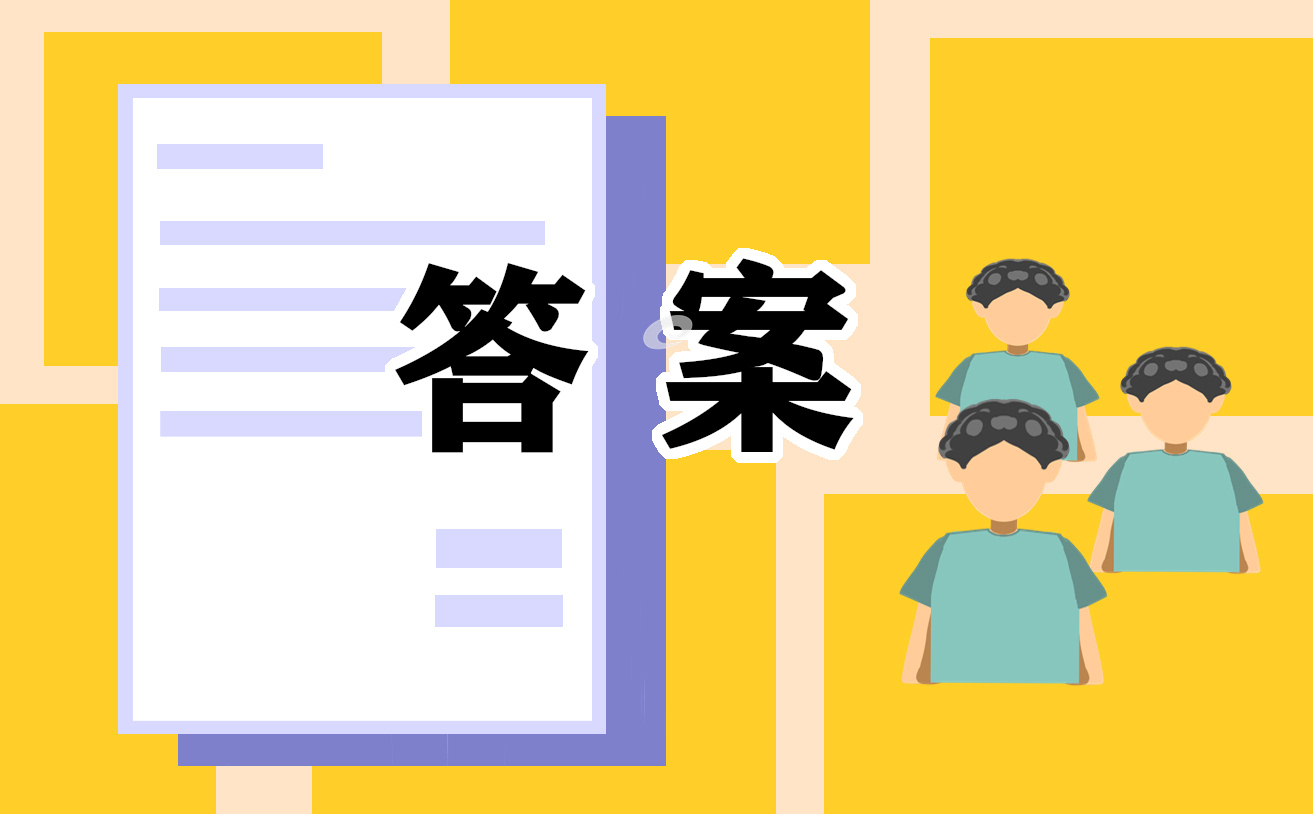六年级英语上册第二单元补充习题答案
英语学习是一个慢功夫,不可盲从,很多人学不好英语是因为一提起学英语就只背单词,其实,想学好英语在课后要多做补充习题巩固练习,下面是小编整理的关于六年级英语上册第二单元补充习题答案的内容,仅供参考,欢迎阅读借鉴!

Unit2Whataday!补充习题答案
A Listen and judge
录音文字稿:
1. It’s a rainy day. Nancy is reading a storybook at home.
2. It’s windy. Wang Bing is flying a kite in the park.
3. It’s sunny. The children are having a picnic in the park.
4. It’s cloudy. Mike walks to school.
参考答案:
1 J
2 J
3 L
4 L
B Listen and choose
录音文字稿:
1. —Were you at home this afternoon,Liu Tao?
—No. I was at school. I played football with Mike in the playground.
2. —I’m hungry, Mum.
—There’s some bread and milk in the kitchen.
3. —Put on your coat, Tim. It’s windy.
—I’m not cold, Mum.
4. —Where were you after school, Helen?
—I was in the park with Nancy. We saw some beautiful parrots there.
5. —Are you hungry, Liu Tao? Here are some cakes.
—No, I’m not. I ate a hamburger just now.
参考答案:
1. b 2. a 3. c 4. c 5. c
C Listen and write
录音文字稿:
1. It was windy in the afternoon. Tom and Jack went to the park by bike. They flew kites there.
2. It was sunny this mo
rning. I played basketball with my friends in the playground. We were very happy.
3. We saw many ants on the bread and cakes. We could not eat our lunch. We were very hungry.
4. For the picnic, we brought some apples, some sandwiches and some drinks.
参考答案:
1. windy, park, flew kites 2. sunny, basketball, playground, happy
3. saw, ants, lunch, hungry 4. picnic, brought, sandwiches, drinks
D Look and say
参考答案:
1. It was a rainy day. We went fishing.
2. It was sunny. We had a picnic.
3. It was windy. We flew a kite.
4. It was cloudy. We went to the cinema.
E Read and match
参考答案:
1. e 2. g 3. h 4. b 5. a 6. c 7. d 8. f
F Read and choose
参考答案:
1. b 2. c 3. a 4. b 5. c 6. c
G Read and answer
参考答案:
1. It was rainy.
2. Because the playground was wet.
3. He tried to dry the playground.
4. Yes, they could.
H Think and write
写作省略
小学六年级英语上册第二单元知识点
一、重点短语:
library 图书馆 post office 邮局 hospital医院 cinema 电影院
bookstore书店 science museum科学博物馆 turn left向左转
turn right 向右转 go straight 直行 north北 south南
east东 west西 next to靠近、与……。相邻 then 然后
二、重点句型:
1.Where is the cinema, please? 请问电影院在哪里?
2.It’s next to the hospital. 它与医院相邻。
3.Turn left at the cinema, then go straight. It’s on the left. 在电影院向左转,然后直行。它在左边。
三、重点语法:
1、问路时要用"excuse me对不起,打扰一下"
2、描述路时可以用顺序词: first首先, next接着, then然后
3、near 表示在附近,next to 表示与…相邻。它的范围比near小。 in front of 在。。。前面 behind 在……后面
4、在左边,在右边介词要用on, on the left/on the right,但是东西南北,介词要用in, in the north/east/south/west.
5、for 表示持续多长时间,当表示做某事多长时间都要用for.? 如:Walk east for 5 minutes.?? Then walk straight for three minutes.
6、乘几路车可以用by the No.301 bus, 注意No.中N要大写,后面要加点。如果要用动词可以用take,例如take the No.301 bus.
7、当表示某个地方在另一个地方的哪一方向时,要用介词of。如:the hospital is east of the cinema. 医院在电影院的东边。
8、表示在哪儿转时,用介词at。 如:Turn left at the bank。在银行左转。
9、find表示"找到",强调找的结果。Look for 表示"寻找",强调找的过程。
10、在几点前面要用介词at,如at 7p.m.
11、英文的书信与中文的书信不完全一样:
开头:英语是在人称后面加逗号,中文是加冒号。
正文:英语是空三个或者五个字母写,中文要空两个中文字格。
结尾:英语的落款与人名是顶格而且是分开写的。中文则是另起一行,放在一起且稍靠后一点儿的地方。英文名字的书写要注意下。
12、近义词:
bookstore==bookshop 书店 go straight==go down直行 after school==after class 放学后
13、反义词或对应词:
here (这里)---there(那里) east(东)---west(西) north(北)---south(南)
left(左)---right(右) get on (上车)---get off(下车)
14、in the front of…表示在…的前面,是指在该地方的范围内,in front of而则表示在该地方的范围外。如:in front of our classroom是指在教室的外面而且在教室的前面。而in the front of classroom则是指在教室里的前面。
15. be far from…表示离某地远。 be 可以是am , is ,are.
My home is not far from school.我家离学校不远。
六年级英语重要知识点
1) 掌握名词复数的变化规则;
1. 多数名词变复数直接在词尾加S。例:book-books
2. 以s,sh,x,ch结尾的一般加es. 例;watch-watches
3. 以辅音字母加y结尾的名词,变y为i再加es. 例;family-families
4. 以f,fe结尾的名词,大多数情况一般将f,fe变为v再加es.例;leaf-leaves
5. 以字母o结尾的名词变复数,多数情况下加s,但有些加es.例;piano-pianos
photo-photos radio-radios tomato-tomatoes
以上情况还有例外,如;有些以-f结尾的名词,在构成复数时只加-s,读作/s/.例;gulf-gulfs
2) 不规则的名词复数变化形式需单独记忆。例如:foot-feet man-men woman-women
Child-children sheep-sheep people-people
六年级英语知识点
1.一般现在时表示经常或习惯性的动作,也可表示现在的状态或主语具备的性格和能力。
2.一般现在时中,没有be动词和情态动词,主语为第三人称单数的肯定句,动词要按规则加上s,主语是非第三人称单数的肯定句,动词用原形。
3.在一般现在时中,句中有be动词或情态动词时,否定句在be动词和情态动词后加not,一般疑问句将be动词或情态动词放在句首。
4.在一般现在时中,句中没有be动词或情态动词时,主语为第三人称单数的否定句在动词前加does+not (doesn’t),一般疑问句在句首加does,句子中原有动词用原形;主语为非第三人称单数,否定句用do+not (don’t),一般疑问句在句首加do,句子中动词用原形。
动词+s的变化规则1.一般情况下,直接加-s,如:cook-cooks, milk-milks2 .以s. x. sh. ch. o结尾,加-es,如:guess-guesses, wash-washes, watch-watches, go-goes3.以“辅音字母+y”结尾,变y为i, 再加-es,如:study-studies
